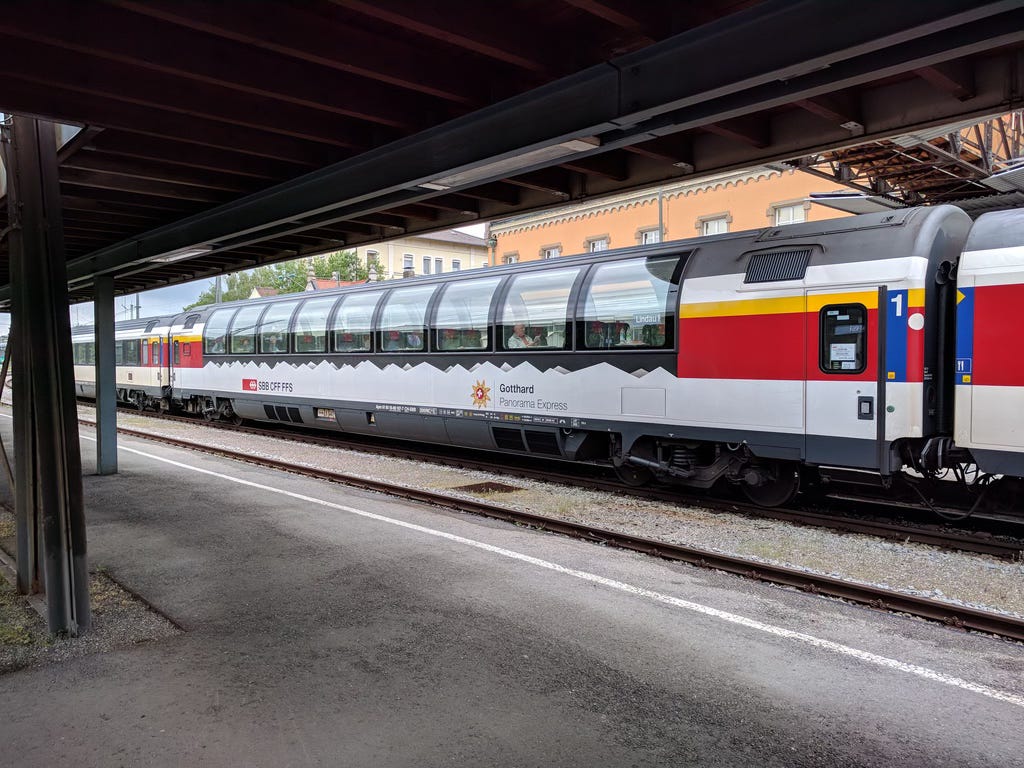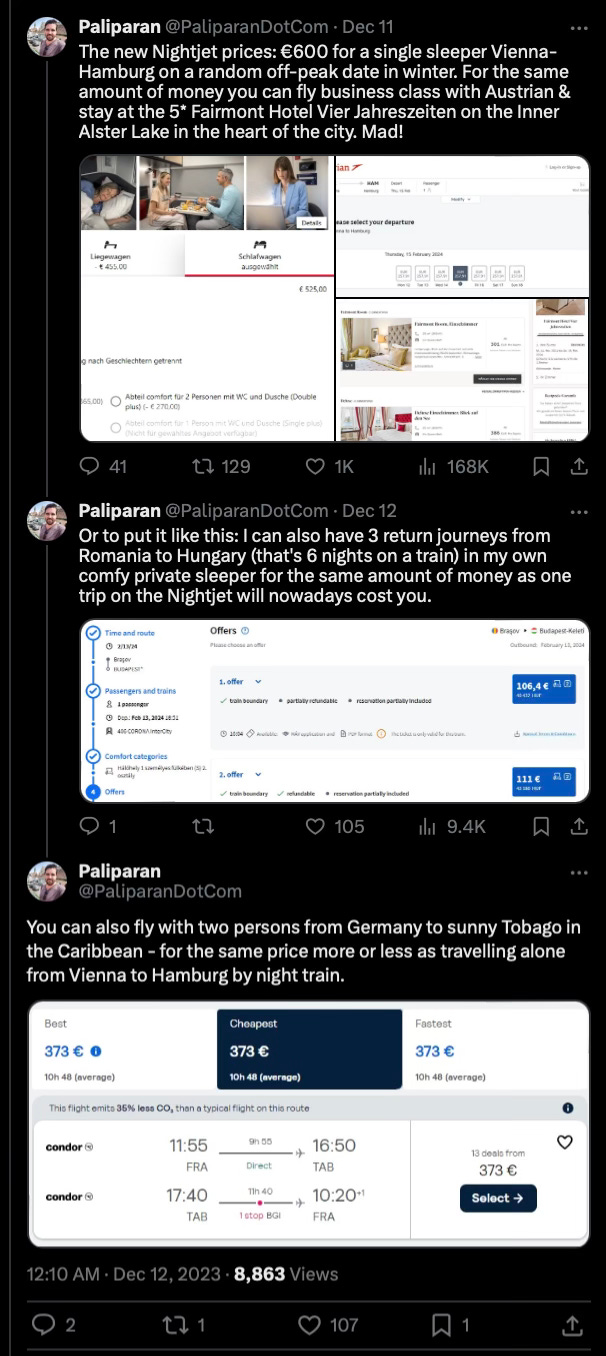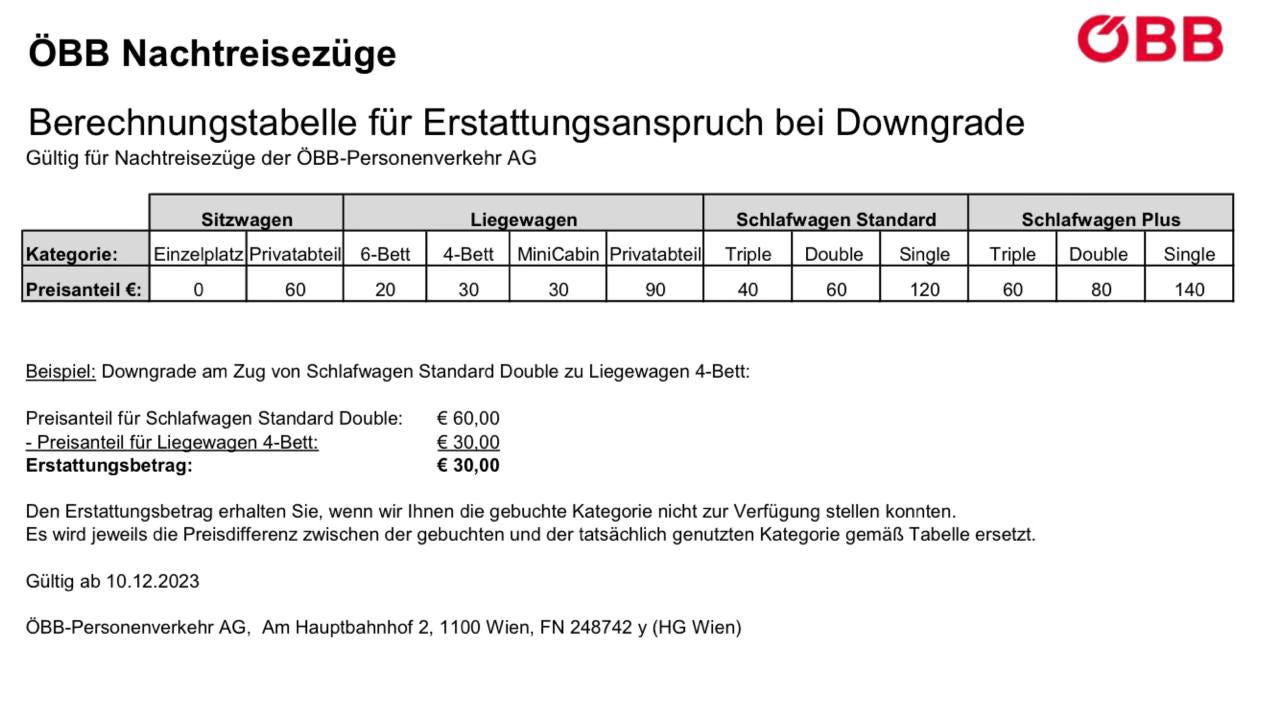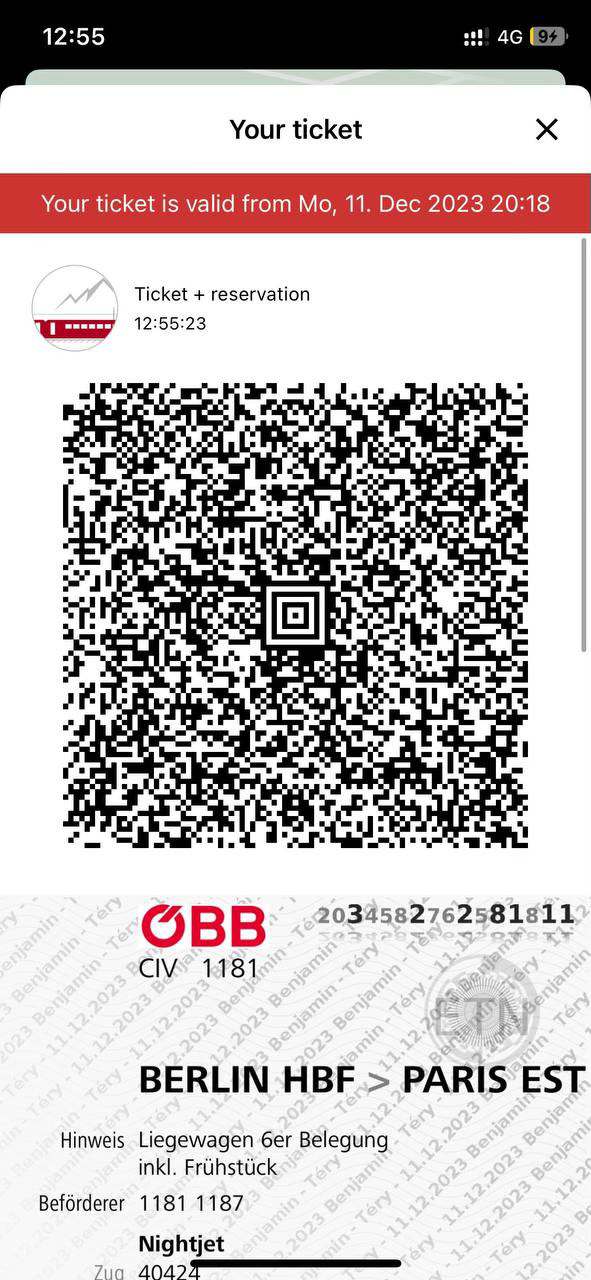European Railways' Turbulent Week
Resurrected dining cars, ÖBB BlightJet, Deutsche Bahn is still Deutsche Bahn, and more
Celebrating new year depends a lot on your culture, religion and calendar. Chinese New Year is celebrated based on lunar cycles, usually in February, Islamic New Year in July, Jewish new year on four different days, Gregorian New Year on the 1st of January, and, if you are in the European BahnBubble, it is usually the 10th-11th of December of each year.
This year, the timetable brings a number of changes, too many to list and analyse in one post – though I will include some of the ones I find the most exciting or interesting at the end of this one – instead focusing on the execution of the new timetable, which has been less than perfect.
ÖBB’s nightjet falters

Pictured above: the old nightjet
First shown off at InnoTrans 2017, ÖBB’s nightjet of the new generation was inaugurated on the Wien - Hamburg and Innsbruck - Hamburg route on the 10th of December. This is not to be confused with the improved couchettes that have been running between Vienna and Bregenz for the better part of a year, as these are part of what ÖBB calls DANI, or Day and Nightjet. The Austrian company ran a small, press-and-YouTuber-only run back in November, but that only ran in Austria and had all the signs of an experience very specifically tailored for everything to work well.
The new trains were thus inaugurated on the route to Hamburg as they have not been certified for any other country but Austria and Germany yet. Italy is the likely candidate to be next, but do not expect these to be going to Paris or Amsterdam just yet – these destinations will retain the old, ex-CityNightLine carriages. What is frustrating however is that over the past few months, it has become a common occurrence for old sleeper and couchette carriages to become unavailable, requiring maintenance, or because of a bed bug infestation. In these cases, ÖBB replaces them with panorama carriages.
(Photo by Charles Fulton / Licence under CC2.0)
I wish I was joking.
During winter, when days are relatively short and the sun comes up relatively late, this is not an issue. But these wagons are not famous for their comfort, and while they provide stunning views, they are not, by any stretch of the imagination, designed for sleeping. Surely, therefore, ÖBB would decide to ensure that passengers are happy and store, perhaps, one functional couchette at each major destination hub? One in Wien, one in Innsbruck, one in Hamburg, one in Amsterdam, perhaps.
Enter: nightjet expansion between France and Germany. To maximise the amount of press coverage they receive for being, ostensibly, the rail only company taking night train expansion seriously1, they have re-launched the night train connecting Berlin with Brussels and Paris. To be fair, these are extremely profitable and popular routes, as proven by private operator European Sleeper’s ability to not only sustain itself but continue to expand its service to Prague. While any expansion in European the European night train network is welcome, I cannot help but feel sorry for all of those who will still have to sleep in a Panorama carriage in 2024 after expecting a couchette or a sleeper.
Finally, ÖBB failed to announce that they are introducing yield management to their night trains. Gone are the days of fixed prices regardless of how soon one intends to travel, instead, ticket prices will move between a minimum and a maximum now, depending on how full the train is.
The new nightjet prices
The table above refers to services to and from the Netherlands (Amsterdam - Innsbruck, Wien, Zürich). The categories of tickets on the left hand side that concern most travellers are Standard, SparSchiene (discounted tickets) and Pass (Interrail or EURail). Zitplaats refers to a seat, Ligplaats refers to a couchette (6/4 berth) and Bedplaats to a sleeper cabin, with Plus including an en-suite shower and toilet. The new prices are, to put succinctly, eye-watering. Attention is immediately drawn to the most expensive, en-suite sleeper, at maximum, costing €1029.90, which has spawned a good amount of productive discourse2 on the social network formerly known as Twitter:
The reason behind the change is twofold. First, ÖBB are the de facto market leaders when it comes to European night trains. They did because they could. Realise that taking on DB’s fleet of night trains was a massive gambit in 2016. It paid off, and now they reap as they have sown. Second, and this is the most likely reason: PSOs have been withdrawn that have benefitted ÖBB in the past, most likely in the Netherlands. The Austrians have proven that they could run a popular night train service, and now they get to do it without the curtailments of subsidy obligations. For the customer, this is the worst of both worlds, as Jon Worth writes in his excellent analysis. The cherry on top of the entire ordeal is the way refunds / downgrades will be handled: it is possible that, after paying €1029.90 for your sleeper, and the sleeper for whatever reason is unavailable, you are downgraded into a couchette and refunded €110.
For those of you who would like to try the new generation nightjet, I would recommend taking it in Austria, to Bregenz: the prices on these remain more affordable than on the international routes. What is most appalling about this whole ordeal is that the way it was (not) communicated. There are few good ways to spin a move that is ultimately a money-grabbing one, and ÖBB realised this quickly, so they have been silent about this on their communication channels.
ÖBB has confirmed the implementation of demand-based pricing and argued that the system has been in place for “a long time”.
Currently, the prices shown in the system have shot up at short notice due to a large number of bookings during the timetable change. In the next few days, the system will recalibrate the prices and significantly cheaper offers can be expected again.
The first few days with new nightjet
The first Wien-Hamburg service, with the new carriages, thus departed on time on the 10th of December. While I maintain that the new features introduced by the Minicabin are very positive, there are definitely teething problems. For German readers, Arian, who works as a train manager on SJ’s EuroNight services, wrote a really long thread that I would definitely recommend perusing. I agree with his points wholeheartedly about the lack of showering facilities for Minicabin passengers – especially as, on the old nightjet, you could realistically slip over to the sleeper carriage even as a couchette customer, take a shower and be ready for the day – but this will not be the case on the new one. The washroom feels crammed from the photos, and while Arian praises the build quality of the new carriages – well done Siemens – he points out that, when locomotives are changed and a power cycle occurs, the entire train reboots, meaning that all lights are turned on to full brightness, toilets flush twice and the control panel is unresponsive for three minutes. The control panel in the new couchettes is nowher near the bed. This needs to be fixed, and needs to be done quickly. Other passengers praised the new nightjet too, mostly for its suspension. Yet, come the 11th, the new night train accrued three hours of delay en route to Hamburg, and this was only the first day: the delays continued, and it seemed that German DB, not ÖBB, has pulled the plug almost entirely on the new carriages until the kinks are ironed out.
On the 11th of December, the train departed Hamburg but only got as far as Nürnberg, where travellers were advised to use alternative services.
On the 12th of December, the stranded train ran to Wien. Since then, sources familiar with the matter have let us know that DB’s long-distance service provider, DB Fernverkehr, have straight-out banned the new night carriages, as the service used high-speed lines without a working emergency brake override, and communication issues between DANI and DB Class 101 locomotives.
ÖBB has not confirmed, nor denied this temporary ban. They confirmed the issue with the DB locomotive, and said that they resolved it with a spare ÖBB locomotive. They the aforementioned technical issues by saying that “there are a few technical fine tuning on the new train necessary”. Coincidentally, night trains between the Netherlands and Austria have been cancelled tomorrow. If I had to guess, those carriages have been re-purposed to serve Hamburg-bound services.
Punctuality data for the Wien-Hamburg nightjet… (source: Zugfinder)
…and for its southbound counterpart.
Then there was the Berlin-Paris sleeper. Again, as this was a returning service, there was a huge amount of hype around it. One enthusiast who had a ticket for the service simply had their reservations cancelled five days before travelling and ÖBB told them to take the bus or a flight. Really. Not running a press-only service, as they did with the new generation nightjet, is acceptable. Kicking people off your service that they had legitimate tickets for is not. The excuse given was that the original sale was a system error and the tickets should not have been allowed in the first place – but this is weak at best. ÖBB confirmed this spin of the story to me as well.
Benjamin Téry’s ticket to the inaugural service, which ÖBB manually cancelled.
Finally, passengers on the Amsterdam-Wien nightjet were thrown off at Nürnberg around 3 in the morning. Then, they were instructed to go over to an unclean sleeping car to continue their journey.
2024: the summer of… seat reservations?
Hoping to evade the PR nightmare that was the announcement of mandatory seat reservations on Amsterdam-Frankfurt ICEs in 2023, DB and NS simply decided to soft launch the news that international ICEs will now require mandatory seat reservations. NS has since caved but DB still has not properly communicated that over the summer, almost all international ICEs, as well as InterCitys and EuroCitys will require a seat reservation. I say almost as the ones to Basel will not. I am ambivalent about this: on the one hand, not having to get reservations makes Germany and its neighbours (except France) immensely more popular among railpass holders, which often leads to crowded trains. This past summer, I travelled on a Brussels - Frankfurt ICE that was crowded enough to render the bathroom inaccessible - people were just everywhere. Ticket checks were not done either. The whole idea of interrail is the freedom to take whichever train one would like, take a seat and travel without worries. The reality is that for most journeys, a seasoned traveller would already be looking at DB Navigator to see the demand level for their upcoming train. I learnt this by having one too many close calls on ICEs between Hamburg and Wien which are always very crowded. The truth is that, for the summer months, this makes absolute sense: trains are crammed and popular.
The international InterCity connecting the Dutch and German capitals will also have mandatory seat reservations – as well as a change in the timetable reflecting that the locomotives need not be changed at Bad Bentheim.
DB has kept seat reservations to single-digit costs, which is a really kind gesture, especially to Interrail / EURail pass holders. SNCF, Eurostar, RENFE, Trenitalia, take note.
2024 will also feature the Olympics in Paris. To celebrate this, SNCB has resurrected InterCity services between Brussels and Paris. These will take slightly longer to complete the journey compared to Eurostar Red services, but they will be significantly more accessible.
News in the East
Some people have too much time on their hands and used it to try ten different dining cars in twenty-four hours – I would recommend watching the video wholeheartedly. Hungarian Dining cars return from Wien to Budapest on EuroNight Dacia, which is fantastic news for any traveller taking the late service.
I will update the post as more news arise.
There are rumours of an order for new rolling stock from SNCF, the French railway company, to be put through by the end of 2024.
Memes.









